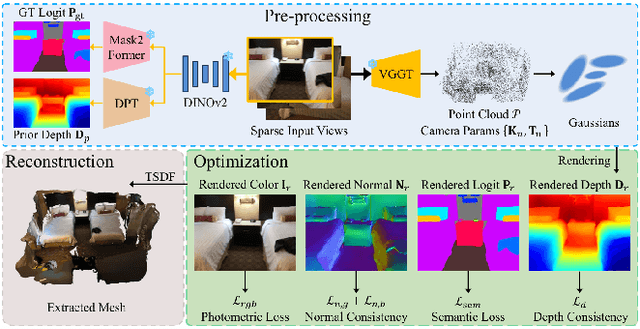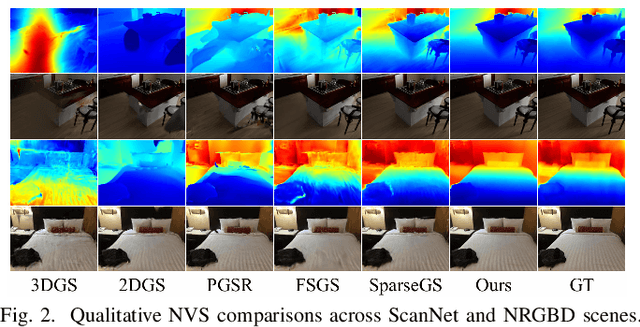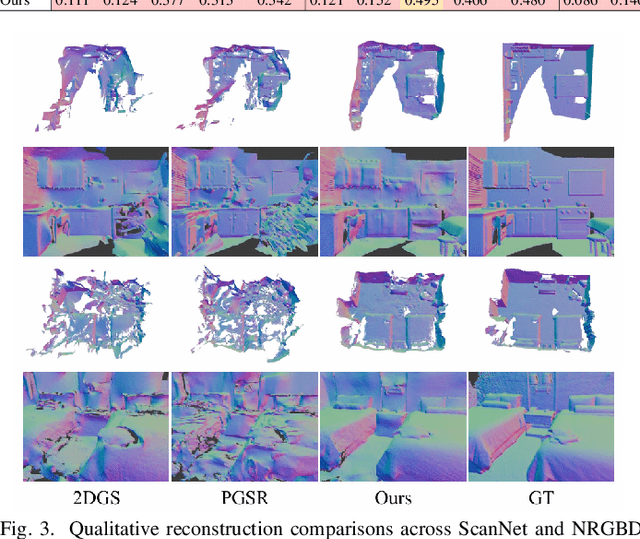Qiang Hu
PrismGS: Physically-Grounded Anti-Aliasing for High-Fidelity Large-Scale 3D Gaussian Splatting
Oct 09, 2025Abstract:3D Gaussian Splatting (3DGS) has recently enabled real-time photorealistic rendering in compact scenes, but scaling to large urban environments introduces severe aliasing artifacts and optimization instability, especially under high-resolution (e.g., 4K) rendering. These artifacts, manifesting as flickering textures and jagged edges, arise from the mismatch between Gaussian primitives and the multi-scale nature of urban geometry. While existing ``divide-and-conquer'' pipelines address scalability, they fail to resolve this fidelity gap. In this paper, we propose PrismGS, a physically-grounded regularization framework that improves the intrinsic rendering behavior of 3D Gaussians. PrismGS integrates two synergistic regularizers. The first is pyramidal multi-scale supervision, which enforces consistency by supervising the rendering against a pre-filtered image pyramid. This compels the model to learn an inherently anti-aliased representation that remains coherent across different viewing scales, directly mitigating flickering textures. This is complemented by an explicit size regularization that imposes a physically-grounded lower bound on the dimensions of the 3D Gaussians. This prevents the formation of degenerate, view-dependent primitives, leading to more stable and plausible geometric surfaces and reducing jagged edges. Our method is plug-and-play and compatible with existing pipelines. Extensive experiments on MatrixCity, Mill-19, and UrbanScene3D demonstrate that PrismGS achieves state-of-the-art performance, yielding significant PSNR gains around 1.5 dB against CityGaussian, while maintaining its superior quality and robustness under demanding 4K rendering.
AlignGS: Aligning Geometry and Semantics for Robust Indoor Reconstruction from Sparse Views
Oct 09, 2025



Abstract:The demand for semantically rich 3D models of indoor scenes is rapidly growing, driven by applications in augmented reality, virtual reality, and robotics. However, creating them from sparse views remains a challenge due to geometric ambiguity. Existing methods often treat semantics as a passive feature painted on an already-formed, and potentially flawed, geometry. We posit that for robust sparse-view reconstruction, semantic understanding instead be an active, guiding force. This paper introduces AlignGS, a novel framework that actualizes this vision by pioneering a synergistic, end-to-end optimization of geometry and semantics. Our method distills rich priors from 2D foundation models and uses them to directly regularize the 3D representation through a set of novel semantic-to-geometry guidance mechanisms, including depth consistency and multi-faceted normal regularization. Extensive evaluations on standard benchmarks demonstrate that our approach achieves state-of-the-art results in novel view synthesis and produces reconstructions with superior geometric accuracy. The results validate that leveraging semantic priors as a geometric regularizer leads to more coherent and complete 3D models from limited input views. Our code is avaliable at https://github.com/MediaX-SJTU/AlignGS .
AutoEmpirical: LLM-Based Automated Research for Empirical Software Fault Analysis
Oct 06, 2025

Abstract:Understanding software faults is essential for empirical research in software development and maintenance. However, traditional fault analysis, while valuable, typically involves multiple expert-driven steps such as collecting potential faults, filtering, and manual investigation. These processes are both labor-intensive and time-consuming, creating bottlenecks that hinder large-scale fault studies in complex yet critical software systems and slow the pace of iterative empirical research. In this paper, we decompose the process of empirical software fault study into three key phases: (1) research objective definition, (2) data preparation, and (3) fault analysis, and we conduct an initial exploration study of applying Large Language Models (LLMs) for fault analysis of open-source software. Specifically, we perform the evaluation on 3,829 software faults drawn from a high-quality empirical study. Our results show that LLMs can substantially improve efficiency in fault analysis, with an average processing time of about two hours, compared to the weeks of manual effort typically required. We conclude by outlining a detailed research plan that highlights both the potential of LLMs for advancing empirical fault studies and the open challenges that required be addressed to achieve fully automated, end-to-end software fault analysis.
Rethinking Testing for LLM Applications: Characteristics, Challenges, and a Lightweight Interaction Protocol
Aug 28, 2025Abstract:Applications of Large Language Models~(LLMs) have evolved from simple text generators into complex software systems that integrate retrieval augmentation, tool invocation, and multi-turn interactions. Their inherent non-determinism, dynamism, and context dependence pose fundamental challenges for quality assurance. This paper decomposes LLM applications into a three-layer architecture: \textbf{\textit{System Shell Layer}}, \textbf{\textit{Prompt Orchestration Layer}}, and \textbf{\textit{LLM Inference Core}}. We then assess the applicability of traditional software testing methods in each layer: directly applicable at the shell layer, requiring semantic reinterpretation at the orchestration layer, and necessitating paradigm shifts at the inference core. A comparative analysis of Testing AI methods from the software engineering community and safety analysis techniques from the AI community reveals structural disconnects in testing unit abstraction, evaluation metrics, and lifecycle management. We identify four fundamental differences that underlie 6 core challenges. To address these, we propose four types of collaborative strategies (\emph{Retain}, \emph{Translate}, \emph{Integrate}, and \emph{Runtime}) and explore a closed-loop, trustworthy quality assurance framework that combines pre-deployment validation with runtime monitoring. Based on these strategies, we offer practical guidance and a protocol proposal to support the standardization and tooling of LLM application testing. We propose a protocol \textbf{\textit{Agent Interaction Communication Language}} (AICL) that is used to communicate between AI agents. AICL has the test-oriented features and is easily integrated in the current agent framework.
FreeVPS: Repurposing Training-Free SAM2 for Generalizable Video Polyp Segmentation
Aug 27, 2025Abstract:Existing video polyp segmentation (VPS) paradigms usually struggle to balance between spatiotemporal modeling and domain generalization, limiting their applicability in real clinical scenarios. To embrace this challenge, we recast the VPS task as a track-by-detect paradigm that leverages the spatial contexts captured by the image polyp segmentation (IPS) model while integrating the temporal modeling capabilities of segment anything model 2 (SAM2). However, during long-term polyp tracking in colonoscopy videos, SAM2 suffers from error accumulation, resulting in a snowball effect that compromises segmentation stability. We mitigate this issue by repurposing SAM2 as a video polyp segmenter with two training-free modules. In particular, the intra-association filtering module eliminates spatial inaccuracies originating from the detecting stage, reducing false positives. The inter-association refinement module adaptively updates the memory bank to prevent error propagation over time, enhancing temporal coherence. Both modules work synergistically to stabilize SAM2, achieving cutting-edge performance in both in-domain and out-of-domain scenarios. Furthermore, we demonstrate the robust tracking capabilities of FreeVPS in long-untrimmed colonoscopy videos, underscoring its potential reliable clinical analysis.
Chimera: Harnessing Multi-Agent LLMs for Automatic Insider Threat Simulation
Aug 12, 2025Abstract:Insider threats, which can lead to severe losses, remain a major security concern. While machine learning-based insider threat detection (ITD) methods have shown promising results, their progress is hindered by the scarcity of high-quality data. Enterprise data is sensitive and rarely accessible, while publicly available datasets, when limited in scale due to cost, lack sufficient real-world coverage; and when purely synthetic, they fail to capture rich semantics and realistic user behavior. To address this, we propose Chimera, the first large language model (LLM)-based multi-agent framework that automatically simulates both benign and malicious insider activities and collects diverse logs across diverse enterprise environments. Chimera models each employee with agents that have role-specific behavior and integrates modules for group meetings, pairwise interactions, and autonomous scheduling, capturing realistic organizational dynamics. It incorporates 15 types of insider attacks (e.g., IP theft, system sabotage) and has been deployed to simulate activities in three sensitive domains: technology company, finance corporation, and medical institution, producing a new dataset, ChimeraLog. We assess ChimeraLog via human studies and quantitative analysis, confirming its diversity, realism, and presence of explainable threat patterns. Evaluations of existing ITD methods show an average F1-score of 0.83, which is significantly lower than 0.99 on the CERT dataset, demonstrating ChimeraLog's higher difficulty and utility for advancing ITD research.
Holistic White-light Polyp Classification via Alignment-free Dense Distillation of Auxiliary Optical Chromoendoscopy
May 25, 2025Abstract:White Light Imaging (WLI) and Narrow Band Imaging (NBI) are the two main colonoscopic modalities for polyp classification. While NBI, as optical chromoendoscopy, offers valuable vascular details, WLI remains the most common and often the only available modality in resource-limited settings. However, WLI-based methods typically underperform, limiting their clinical applicability. Existing approaches transfer knowledge from NBI to WLI through global feature alignment but often rely on cropped lesion regions, which are susceptible to detection errors and neglect contextual and subtle diagnostic cues. To address this, this paper proposes a novel holistic classification framework that leverages full-image diagnosis without requiring polyp localization. The key innovation lies in the Alignment-free Dense Distillation (ADD) module, which enables fine-grained cross-domain knowledge distillation regardless of misalignment between WLI and NBI images. Without resorting to explicit image alignment, ADD learns pixel-wise cross-domain affinities to establish correspondences between feature maps, guiding the distillation along the most relevant pixel connections. To further enhance distillation reliability, ADD incorporates Class Activation Mapping (CAM) to filter cross-domain affinities, ensuring the distillation path connects only those semantically consistent regions with equal contributions to polyp diagnosis. Extensive results on public and in-house datasets show that our method achieves state-of-the-art performance, relatively outperforming the other approaches by at least 2.5% and 16.2% in AUC, respectively. Code is available at: https://github.com/Huster-Hq/ADD.
NTIRE 2025 challenge on Text to Image Generation Model Quality Assessment
May 22, 2025Abstract:This paper reports on the NTIRE 2025 challenge on Text to Image (T2I) generation model quality assessment, which will be held in conjunction with the New Trends in Image Restoration and Enhancement Workshop (NTIRE) at CVPR 2025. The aim of this challenge is to address the fine-grained quality assessment of text-to-image generation models. This challenge evaluates text-to-image models from two aspects: image-text alignment and image structural distortion detection, and is divided into the alignment track and the structural track. The alignment track uses the EvalMuse-40K, which contains around 40K AI-Generated Images (AIGIs) generated by 20 popular generative models. The alignment track has a total of 371 registered participants. A total of 1,883 submissions are received in the development phase, and 507 submissions are received in the test phase. Finally, 12 participating teams submitted their models and fact sheets. The structure track uses the EvalMuse-Structure, which contains 10,000 AI-Generated Images (AIGIs) with corresponding structural distortion mask. A total of 211 participants have registered in the structure track. A total of 1155 submissions are received in the development phase, and 487 submissions are received in the test phase. Finally, 8 participating teams submitted their models and fact sheets. Almost all methods have achieved better results than baseline methods, and the winning methods in both tracks have demonstrated superior prediction performance on T2I model quality assessment.
Controllable Image Colorization with Instance-aware Texts and Masks
May 13, 2025Abstract:Recently, the application of deep learning in image colorization has received widespread attention. The maturation of diffusion models has further advanced the development of image colorization models. However, current mainstream image colorization models still face issues such as color bleeding and color binding errors, and cannot colorize images at the instance level. In this paper, we propose a diffusion-based colorization method MT-Color to achieve precise instance-aware colorization with use-provided guidance. To tackle color bleeding issue, we design a pixel-level mask attention mechanism that integrates latent features and conditional gray image features through cross-attention. We use segmentation masks to construct cross-attention masks, preventing pixel information from exchanging between different instances. We also introduce an instance mask and text guidance module that extracts instance masks and text representations of each instance, which are then fused with latent features through self-attention, utilizing instance masks to form self-attention masks to prevent instance texts from guiding the colorization of other areas, thus mitigating color binding errors. Furthermore, we apply a multi-instance sampling strategy, which involves sampling each instance region separately and then fusing the results. Additionally, we have created a specialized dataset for instance-level colorization tasks, GPT-color, by leveraging large visual language models on existing image datasets. Qualitative and quantitative experiments show that our model and dataset outperform previous methods and datasets.
FineVQ: Fine-Grained User Generated Content Video Quality Assessment
Dec 26, 2024



Abstract:The rapid growth of user-generated content (UGC) videos has produced an urgent need for effective video quality assessment (VQA) algorithms to monitor video quality and guide optimization and recommendation procedures. However, current VQA models generally only give an overall rating for a UGC video, which lacks fine-grained labels for serving video processing and recommendation applications. To address the challenges and promote the development of UGC videos, we establish the first large-scale Fine-grained Video quality assessment Database, termed FineVD, which comprises 6104 UGC videos with fine-grained quality scores and descriptions across multiple dimensions. Based on this database, we propose a Fine-grained Video Quality assessment (FineVQ) model to learn the fine-grained quality of UGC videos, with the capabilities of quality rating, quality scoring, and quality attribution. Extensive experimental results demonstrate that our proposed FineVQ can produce fine-grained video-quality results and achieve state-of-the-art performance on FineVD and other commonly used UGC-VQA datasets. Both Both FineVD and FineVQ will be made publicly available.
 Add to Chrome
Add to Chrome Add to Firefox
Add to Firefox Add to Edge
Add to Edge